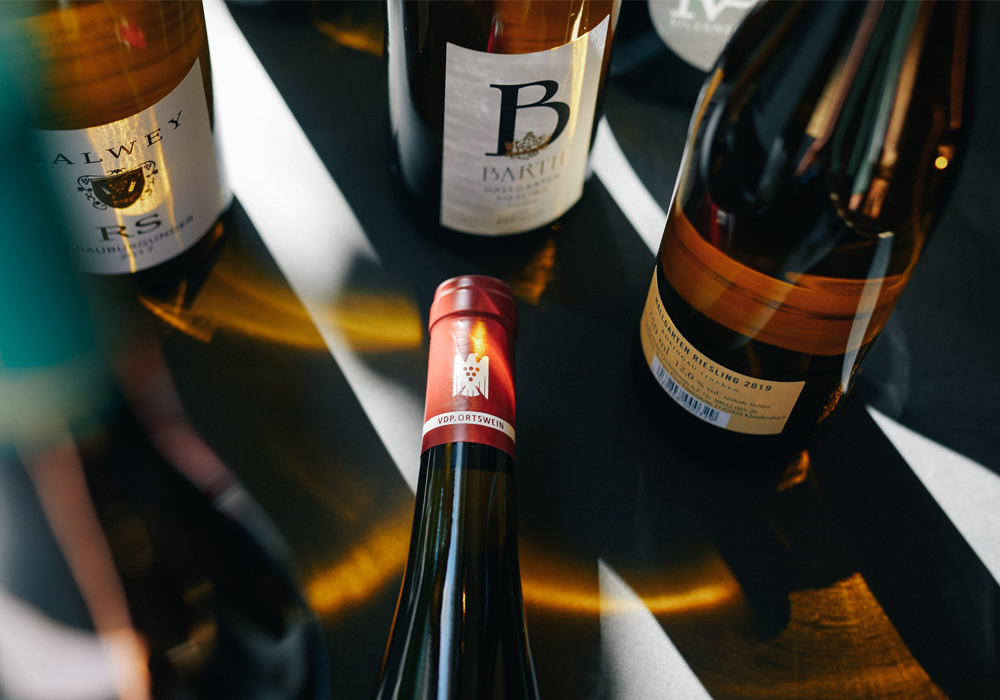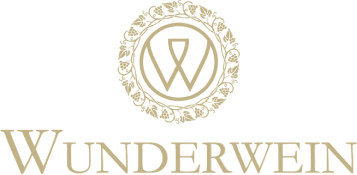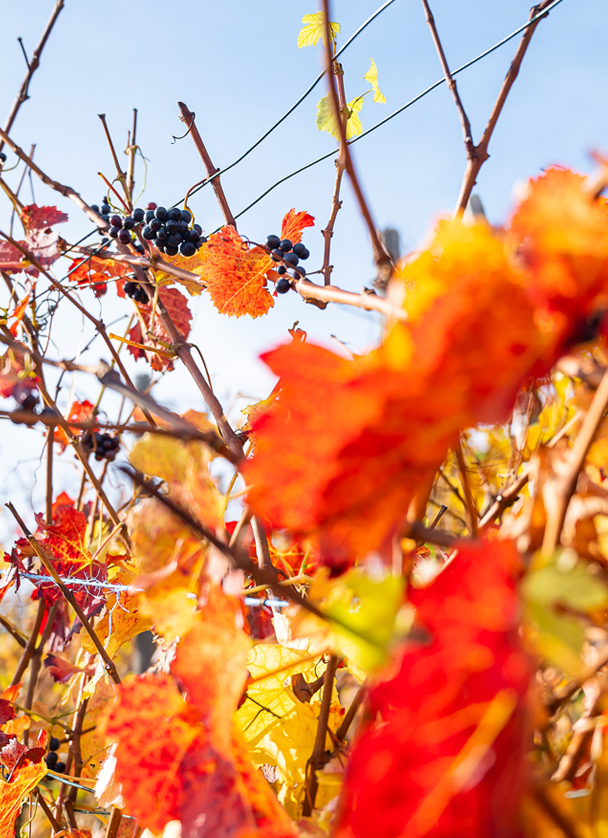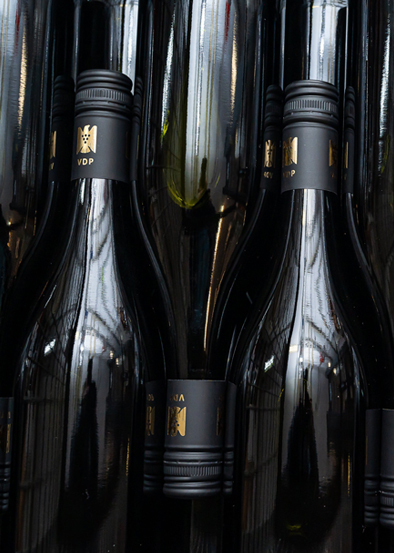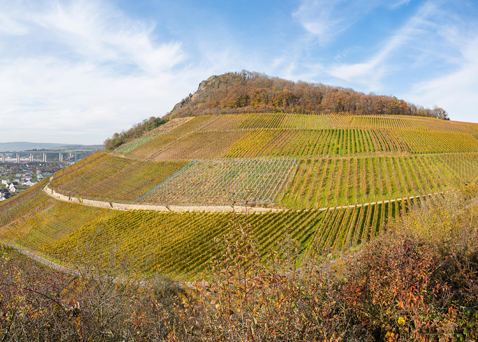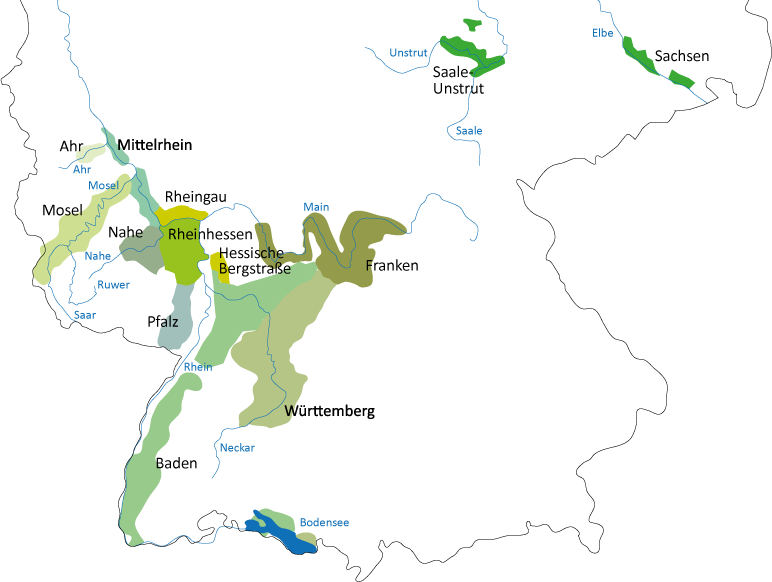
Thirteen Regions
Ahr
The expression “small is beautiful” has never been truer than when describing Germany’s Ahr wine region. This tiny stretch of vineyards covers only 560 hectares with plots mostly concentrated along 25 kilometers of the river Ahr from the village of Altenahr to the mighty Rhine. With its steep terraced vineyards and charming hamlets, this picturesque wine region located in the state of Rhineland-Palatinate wins our hearts over every time we visit.
Church documents from 9th century show that winemaking was already firmly established in Ahr all those years ago and some say the Romans were the first to experiment with vines in this compact, fertile valley. Present day vineyards comprise one district site, one collective vineyard and 40 private plots. Certified VDP sites in Ahr include Landskrone and Burggarten in Heimersheim and Pfarrwingert and Hardtberg in Dernau.
History aside, we think what makes the Ahr region so attractive is its unexpectedness. Who would think such a dot on the map (it is the third smallest of Germany’s 13 wine regions) would be such a treasure trove of quality wines and be dripping with awards for its winemaking?
It is not just its size that makes Ahr so remarkable. It is Germany’s northernmost wine producing region. Its signature wine is a red – Spätburgunder, otherwise known as Pinot Noir. Red grape varietals account for about 86% of fruit in Ahr with Spätburgunder its flagship wine. This region is famed for producing light red, deliciously fruity, dry, tannic expressions of this grape with a prominent oak tones.
Other red wines include Portugieser and Frühburgunder each reflecting a unique and nourishing terroir. Those pretty slopes and winding vineyards are not just for show! The narrowness of the Ahr valley and protective Eifel mountains create a Mediterranean micro-climate ideal for the ripening of red grapes. Add to this southwest and southeast facing vines and meticulous winemaking techniques and it is little surprise that you find gem after gem in your glass.
Ahr is also known for a handful of top-quality whites including Riesling, Pinot Blanc and Pinot Gris. These grow alongside the indigenous Regent, Dornfelder, and Domina and Swiss Müller-Thurgau. The high caliber of Ahr wines means top prices although there is an increasing number of excellent entry level wines on offer.
Another adage that suits Ahr is “quality not quantity”. This is the only “problem” we have with this jewel-like region. Ahr’s wonderful wines are soaked up by the high domestic market demand so can be hard to get hold of internationally. Really this is a “problem” we like because it means we have an excuse to visit more often and discover remarkable wines for you!
Baden
Sun-drenched and brimming with bonhomie (and a healthy pinch of hedonism!), the southwestern area of Baden is the third largest and the warmest of the German wine regions. Blue-skied and rich in history, Baden boasts pretty towns like Heidelberg, Karlsruhe, Baden-Baden and Freiburg plus luxurious spas and delicious cuisine. The story of winemaking goes back a long way here with medieval records showing nobility patronizing the trade from the 12th century. While Baden offers the perfect weekend getaway for its culture and cuisine, what draws us back time after time is its marvelous array of red and white wines.
This southwestern region stands out on the wine map for its quirky L-shaped, 400 km tract made up of nine subregions covering 16,000 hectares of vineyards. Extending between the Rhine River and the Black Forest, Baden is famed for its world-class reds. Spätburgunder, known outside Germany as Pinot Noir, rules the roost with 33% of vineyard plantings. Expressions of this varietal are dry and highly acidic with earthy notes and a sweet plummy finish. While Pinot Noir dominates as a varietal, a mix of whites take up 60% of vineyards. These wines are pale lemon to golden in color and renowned for their dry minerality and acidity.
The sub climates in Baden are diverse. From one vineyard to the next, the orientation toward the sun and the all-important terroir changes as do the varietals. In northernmost Tauberfranken and Kraichgau, Rivaner, Riesling and Pinot Meunier reign. In the middle of the Ortenau, Pinot Noir, Riesling (or Klingelberger) and Spicy Gewürztraminer (also known as Clevner) grow, and in the south, Breisgau red and white pinot is the mainstay. The ancient variety Gutedel grows in Markgräflerland while Lake Constance yields Pinot Noir and Müller-Thurgau.
The overall picture we take away is that of sun streaming down the valleys and glistening on the Rhine all courtesy of the protection of the Black and Oden Forests. This extra dose of light results in fuller-bodied and higher alcohol content wines than the rest of Germany. Baden is the only wine area in Germany to have earned the European Union Category B winemaking zone stamp. In short, this means the grapes are naturally extra sweet! This is one of the reasons we love them
Baden is rich in wine festivals with over 100 events taking place up and down this unique region each year. In spite of such world-class winemaking though, Baden wines have not traveled as far in fame as those from nearby Alsace, the renowned wine region in France located just across the Rhine. We know that Baden wines, with their diversity, depth and flavor, deserve wide appreciation and accolades. It is tempting to keep them to ourselves, but we cannot be so selfish when it comes to fine wine so will continue to share everything we know about this cheerful wine region with you!
Franken
We know we have arrived in Franken wine territory when we see the confident and elegant Bocksbeutels appear in the cellars and taverns. Rounded in shape and flat with a long neck, these bottles are emblematic of lovely-tasting wines of the highest quality.
An area known in English as Franconia, the cultivation of wines on the south-facing inclines along Franken’s Main River goes back more than a millennium. In the north, this iconic German wine region borders the Rhön mountains and in the south, the Taubertal River. In the east its far reaches are marked by the hilly Steigerwald while in the west, the low Spessart mountains mark its limit. Within these four natural boundaries is where we taste the magic.
Franken comprises just over 6,000 hectares of vineyards with four-fifths given over to whites. The flagship varietal is Silvaner, full bodied with gentle acidity. Once the most important grape in Germany we are thankful it is still the star of the show in Franken because it reflects its terroir with intricate accuracy expressing florals, fruit or vegetal notes. Silvaner thrives in Franken’s limestone-rich soil and seems to go hand-in-hand with a Bocksbeutel (we are sure the signature bottle shape enhances its flavor!). Close on Silvaner’s heels is the delicate, aromatic Müller-Thurgau which is fast gaining ground as the preferred varietal for the younger generation of Franken winemakers. Bacchus, light-footed on the nose and palate is also a local favorite. Each of these varietals suits the warm, dry summers and cold winters of Franken displaying fresh and lively personalities in the glass.
The main town and cultural center in Franken is Würzburg. Beautifully baroque, it surrounded by a patchwork of historical vineyards like Würzburger Stein. The German philosopher Goethe was a fan of Silvaners and Rieslings from this plot and if they were anything like the masterfully balanced modern-day Steinwein produced here, we back him up 100%. Many Würzburg wineries open their doors for tours and tastings. We always make sure we visit at least one and, if time allows, three or four; the wine is wonderful and the tasting room architecture majestic.
This region has won countless awards both in Germany and globally, so we think it is a crime that 80% of Franken wines are sold a stone’s throw from where they are crafted. We get why the locals want to get their hands on the exceptional local wines, but our mission is for you to have the experience of Franken Silvaner, Müller-Thurgau and Bacchus as well.
Mittelrhein
Survival of the fittest is the name of the game in the breath-taking Mittelrhein wine producing area. The steep slopes along the Rhine are incredibly difficult to cultivate but that has not stopped winemakers from the Roman age to the present-day craft exquisite wines from its sun-soaked clay and slate rich soils.
Stretching 65 kilometers between Bonn and Bingen, this fertile valley is called "the Rhine Gorge" and famed for its vineyard terraced slopes and dramatic medieval castles. So rich is this region in culture and history its southern area, the Upper Middle Rhine Valley gained UNESCO World Heritage Site status in 2002. Another remarkable feature of the Mittelrhein is the Bopparder Hamm the biggest contiguous vineyard in the Mittelrhein, spreading around the town of Boppard and covering five kilometers. Packed with the stuff of German legends like the Loreley rock and castle ruins, this region makes a magnificent backdrop for marvelous wines.
The area under vine amounts to 468 hectares over two districts, 11 collective sites and around 100 private plots. Riesling holds sway here covering about two-thirds of plantings and making the fine mineral wines with glittering acidity that we enjoy so much. Müller-Thurgau, Pinot Gris and Pinot Blanc are also cultivated while Spätburgunder is the leading red.
Creating quality wines from such difficult terrain is a challenge but vintners have found a way, taking advantage of all that nature has offered them. They go for low yield production in order to get the best grapes for the best wines and the heat and light reflected from the Rhine keep the grapes growing to perfection, as they have for thousands of years.
Mittelrhein is dripping with charming towns and villages rich in history and wine culture. Wine shops and taverns abound in their winding alleys making getting lost a pleasure – and we speak from experience! Leading wine-growing city Koblenz is another highlight as are the fascinating St. Goar, and Oberwesel, and the old wine trade town of Bacaharach.
The touring destinations are numerous. In the heart of this unique river landscape is Koblenz, one of the largest wine-growing cities. St. Goar, Boppard and Oberwesel, with its almost completely preserved city wall, are also highlights as is the picturesque old wine trade center of Bacharach.
Spring is the time for new vintage release at the Weinfrühling (spring wine) festival. Fall ushers in the WeinforumMittelrhein where you can sample award-winning wines from the region.
Like other small regions, the vast majority of wine produced in Mittelrhein is consumed locally. With our Mittelrhein range we are happy to turn you into a local wherever you are in the world!
Mosel
This ancient wine-producing region acts as a true test to dedication to the vines; it has some of the steepest vineyards in Europe with many angled at 70-degree gradient. Breath-takingly pretty it certainly is, and the inclined, terraced vineyards take commitment from vignerons who are not afraid of hard work or heights! Fruit has to be picked the old-fashioned way - by hand as there is not a machine on earth that could manage these precipitous heights.
Located over 250 kilometers, the twisting and turning Mosel River and its two tributaries, the Saar and the Ruwer, carve out 8,744 hectares of vineyards between the Hunsrück and Eifel hills. It covers six districts comprising 19 collective vineyard sites and 500 private plots.
As well as having dizzyingly sheer vineyards, the Mosel Wine Region is regarded as the oldest in Germany. The Romans have left behind presses and other wine artifacts hinting at long and widespread viticultural activity.
Riesling is king here covering 62.2% of wine production and it thrives in the varying sand and clay, grave and limestone soils of the towering vineyards. The valley conditions create warmth, and the steep slopes absorb the day's intense sunlight to cast it up again to the vines for further heat throughout the night. Indeed, Mosel growers consider themselves the specialists in this varietal - and rightly so. Vine roots dig deep into the earth for water and mineral leading to elegant, fruity Rieslings with good body and low alcohol.
The Mosel, the fifth largest wine region in Germany, also favors Müller-Thurgau, Pinot Blanc and Pinot Noir. The ancient Elbling grape makes wonderful fruit-forward sparkling wine. The Mosel is also famed for its noble sweet wines, some of which come at hefty prices!
With towns like Koblenz, Cochem, Zell, Bernkastel, Piesport and Trier dotted around this region, the Mosel is perfect for wine, spectacular scenery, cuisine and culture. We cannot get enough of it and are delighted to share it with you.
Nahe
This jewel of a region is something of a best kept secret in the German wine world and one we love shining a spotlight onto. Named after the river that softly rolls through the Hunsrück Hills toward Bingen on the Rhine, the Nahe Wine Region boasts vineyards and orchards that suddenly give way to sheer cliffs and intriguing rocky mounds.
Protected by the Hunsrück, the temperature is mild and coupled with abundant sunshine and low rainfall, a paradise for wine. A feature of the Nahe and something we always enjoy seeing first-hand is the huge range of soils. Whether volcanic, slate, clay, sandstone or limestone, they tell a fascinating geological tale and enable cultivation of a range of varietals and styles of wines.
The region encompasses 4,239 hectares featuring one district, seven collectives and 300 individual vineyards. Whites lead in the Nahe covering 76.2% of vineyards. Exquisite, light and spicy Riesling is the mainstay with floral Müller-Thurgau also making its mark. Earthy Silvaner, plus fresh Pinot Gris and Pinot Blanc are popular while Dornfelder and Spätburgunder produce balanced wines here.
Such an inviting landscape lends itself to outdoor activities with many being wine related. Hikers can enjoy the marvelous 100 km "Rhine-Nahe Wine Trail" in the Soonwald Nahe Nature Park. We have dipped in and out of this trail over the years and heartily recommended local cuisine and a glass of the aromatic, mineral rich wine afterward. Charming towns Bad Münster am Stein-Ebernburg, Bad Kreuznach, and Bad Sobernheim host numerous wine events featuring live music and culinary delights that also go well with a sip or two of local wine!
The region is also renowned for its wellness offerings. Its towns are centers for spas and mud baths. Vinotherapy, beauty treatments using grape products, is also on the rise. Sounds good but while we cannot offer you that kind of therapy from Nahe, we can bring you the kind that comes in a glass with our range of the local best.
Pfalz
Pfalz, located between forested Haardt Mountains and the Rhine plain and extending to the French border, has the distinction of being Germany’s forefront red wine region. Whites constitute the cornerstone with 67.5% of wine production but reds make up 34.3% in this 23,684 hectares of wine country. We always make sure we have a glass or two of red when local, especially the dry, richly-colored and complex Dornfelder which has been causing a stir for a few years now.
Rieslings, dry and full bodied with teasing acidity, reign with nearly a quarter of plantings. Pfalz is also home to growing plantings of Pinot Blanc and Pinot Gris. Silvaner, Müller-Thurgau, Gewürztraminer, Kerner and Morio-Muskat also find a welcome place to grow as do international varietals Chardonnay and Sauvignon Blanc.
Reds thrive in Pfalz too. As well as Dornfelder, we enjoy a glass of Weissherbst or rosé from the vibrant Portugieser grape, a juicy Pinot Noir or well-structured Regent.
The second largest of Germany’s wine growing regions, constitutes two areas, Mittelhaardt-Deutsche Weinstrasse and Südliche Weinstrasse. Vines flourish in a range of sandstone, loam, chalk, clay and sandy soils all smiled on by plentiful sunlight.
Pfalz is the perfect spot for anyone who wants to celebrate wine. The town of Bad Dürkheim hosts one of the world’s biggest wine festivals in September and visitors also flock to the region to walk the Deutsche Weinstraße wine route. This runs for more than 85 kilometers connecting 130 wine-producing towns across a charming, sweeping landscape between Bockenheim and Schweigen on Alsace’s border.
From spring through late fall wine events abound. We have had loads of fun here, especially in August at the Deutsche Weinstrasse Erlebnistag when 85 kilometers of road are closed for a seemingly never-ending local wine and food fest. As you taste our splendid Pfalz wines, that just leaves us to say, Prost!
Hessische Bergstrasse
While the rest of Germany is still wearing a scarf and gloves, spring is already opening its arms in the Hessische Bergstrasse wine region. The plentiful sunshine brings magnolia and forsythia into bloom and cherry and apricot trees make a pretty backdrop to the charming old towns of Zwingenberg, Heppenheim, Alsbach and Bensheim. It also brings a glow to the grape varietals grown locally as does a terroir of porphyry-quartz, granite, sand and loess-loam. Wines here are deliciously dry and semi-dry.
When you sip our wines from this region picture an 80-kilometer-long straight Roman road, an ancient trade route dotted with picturesque spots and beautifully crafted wines. This is called the Bergstrasse or Mountain Road. It encompasses 463 hectares covering two wine districts, three collectives and 20 individual sites.
White wines lead the way here with 79% of vineyards given over to their production. Riesling is the main grape by far covering nearly 40% of production. Pinot Gris follows along with Pinot Noir, Pinot Blanc and Silvaner. Additional reds include Dornfelder and St. Laurent which are steadily making their mark.
Since 1971, the part of the Bergstrasse that winds its way through the state of Hesse has produced wines independently with vineyards becoming more frequent as you hit Zwingenberg. Winemaking is concentrated around Auerbach, Bensheim and Heppenheim. This area ends south of Heppenheim on the Hessian border. The second, much smaller area, "Umstadt Area", has its epicenter in the city of Gross-Umstadt. Affectionately, it is known as the "Odenwald Wine Island" because of its slightly isolated position in the Hessische Bergstrasse.
One of our favorite things to do here is to hike along the Bergsträßer Weinlagenweg, a delightful trail that cuts right through swathes of vineyard. The views are out of this world and, if you are here on May 1st, winemakers invite you to hike through their vineyards. This activity is part of the Bergsträßer wine meeting which Bensheim hosts.
Plenty of wine festivals follow which we love visiting as we get to try wines we would otherwise not even know existed. When Pentecost rolls around, Zwingenberg holds a wine festival in its striking historic square while Heppenheim puts an excellent selection of local wines on display in June. September hails in events in Bensheim and Gross-Umstadt celebrate in September. If you visit out of season, you can find rare locally produced wines in the restaurants and taverns that line the Bergstrasse. We bring you the best as well.
Rheingau
With its near right angle turn of the Rhine from a northern to western course, this region easily stands out on a map. It is here, along this 30 km journey west before it veers north once again that the lion’s share of Rheaingau’s vineyards is located, soaking up the sun. This stretch also includes vineyards around Assmannshausen and Lorch. Hochheim on the Main river is part of this region too are the vineyards of Lohrberger just east of Frankfurt am Main. In all, this region covers 50 km encompassing 3,185 hectares of land under vine. Tightly packed with vines and wine-producing villages, we can vouch for the fact that this is ideal if you can only allow for a few days’ exploring. Tourist routes are clearly signposted; by car there is the Rheingauer Riesling Route, hikers can enjoy the Rheingauer Riesling Pfad and for cyclists, there is the Rheingauer Radwanderweg. Each offers you stunning vistas, picturesque villages and fascinating monastic ruins with top standard cuisines and Rheingau wine to enjoy after appreciating the regional beauty.
Despite is relatively small hectarage, soil types are diverse with chalk, sand, gravel, all types of clay, loess, quartzite and slate all contributing to the top tier wines that come out of Rheingau. Compact and enjoying excellent growing conditions courtesy of the protective forested peaks of the Taunus Mountains to the north and the heat reflecting Rhein, Riesling is the main grape in the Rheingau covering 77.7% of production. The region has a reputation for premier dry, peachy, full bodied styles of this favorite German varietal. Spätburgunder also flourishes here with a 12.2% share of production, making top quality expressions of this variety. We also enjoy Rheingau Müller-Thurgau.
Humidity from the Rhein creates ideal conditions for Beerenauslese and Trockenbeerenauslese sweet wines. Indeed, this region is known for producing some of the best in Germany. Rheingau Riesling Spätlese is also one of the finest of its style.
Rheinhessen
Germany's largest wine region with 26,860 hectares, Rheinhessen is located on the Rhein within the gently rolling hills of what is known as “Rheinhessen's Switzerland”, the Taunus Hills and the Oden Forest. Framed by the Nahe River to the west and the Rhine to the north and east, this warm-climate region with its varied soils is home to numerous crops. Grapes are but one of them - but what extraordinary grapes!
A limestone and loam, sandy, gravelly terroir is ideal for a wide range of varieties both well-established and up and coming. Rheinhessen also boasts plots with a red, clay soil and sites where quartzite-slate dominates. No wonder so many types of grape thrive here, and the region’s wines are so juicy and earthy.
With whites covering a 71.7% share of production, Riesling leads with 18.1% while Müller-Thurgau (of Liebfraumilch fame) is close behind with 15.2%. Rheinhessen is home to the biggest area planted with the much-loved Silvaner grape. Vibrant red Dornfelder accounts for a significant 12.5% of wines in Rheinhessen and further whites Pinot Gris, Pinot Blanc and Kerner are also making a name for themselves. Versatile Portugieser and classic Pinot Noir round up the portfolio of reds in this region of eclectic varietals. This wide, high-quality selection impresses us each time we visit and makes it that bit harder to leave!
One of the fascinating features of Rheinhessen is the variety of styles in which wines are made. Whether classic or modern, dry or sweet is your thing, you will find a wine to suit your tastes from the bountiful wine offerings of this large region. Renowned for its experimentation over the decades, young regional winemakers are making their mark with well balanced, aromatic, soft wines with beautiful minerality.
Main towns include Mainz, Worms, Alzey and Bingen where you can enjoy a wide scope of cuisine mirroring the variety of grapes. You can also take in a vineyard hike or bike tour along the Herbal Trail of Rheinhessen’s Switzerland.
Saale-Unstrut
Vines have been grown in the Saale-Unstrut wine region since AD 998, a pretty area characterized by sheer terraces, orchard meadows and glittering streams. Defined geographically by the homonymous rivers winding their ways through the Saale-Unstrut Wine Region, it has the distinction of being one of Europe's northernmost wine growing areas and Germany's most northern.
An area vulnerable to spring and winter frosts and a relatively low average annual temperature is tempered by vineyards grown on heat-releasing stone terraces and south-facing plots. Warmth accumulates in the river valleys allowing steady, beautiful grape ripening. Saale-Unstrut, with its 798 hectares, is also one of the driest in Germany.
Shell-limestone and colored sandstone soils nourish vineyards with close to a quarter comprising white fruit and just over 25% red. The main grape is Müller-Thurgau which makes wines with concentrated yet delicate orchard fruit tones and gentle acidity. We always go out of our way to enjoy a glass every time we are in this neck of the woods. Weissburgunder (aka Pinot Blanc) follows with Riesling right behind. Classic varietals Bacchus and Silvaner are other whites that love Saale-Unstrut. Dornfelder is making waves for the reds. Spätlese and Auslese styles are produced but only in the very warmest years.
Owing to its climatic conditions and northern aspect, Saale-Unstrut vineyards produce a naturally reduced, high-quality yield of only 50 hectoliters per acre. The resulting wines are dry and vibrant with fruity finesse. Most wine is enjoyed locally but someone has heard about this jewel of a region because it has received accolades and awards from the industry over the years.
The Saale-Unstrut Wine Route features the "Romanesque Road" and the "Skywalk" which takes in castles and palaces, cathedrals and sacred sites dotted around the main towns of Naumburg, Bad Kösen, and Freyburg. This latter spot hosts the biggest wine festival in the region every September.
We look forward to sharing our fresh and unique wine finds from this boreal region with you.
Sachsen
Sachsen, known as Saxony in English, is one of Germany's smallest wine-production areas and also its easternmost. Records show the wine trade has been alive here for more than 800 years. The region once boasted 5,000 hectares of vineyards.
Today Sachsen vineyards cover 492 hectares growing along the steep, terraced slopes of the Elbe River. Close to82% are devoted to white varietals. Müller-Thurgau, Riesling and Pinot Blanc are the leading grapes with Pinot Gris and Pinot Noir also cultivated in this region’s continental climate.
Major towns are Dresden, Radebeul and Meissen where Sachsen’s largestwine festival takes place. A unique feature of this picturesque region is the historical connection between winemaking and architecture. Many buildings, both sacred and secular bear features of this past. We love the vintner houses and vineyard churches.
Handpicking is the norm and yields are low leading to a high quality dry, complex wines that barely make it outside the locale. Sachsen wines are rare indeed which is why we are so delighted to share our top finds with you. As well as the three leading whites of this area, more obscure varietals like Elbling, Gutedel or the bright and floral Goldriesling, almost exclusive Sachsen, find a home here.
In spite of its tiny size, Sachsen has a vibrant wine tourism scene, a charming backdrop to its splendid wines. We have enjoyed whites and reds in welcoming wine taverns and fine dining spots, at fall festivals and in chic wine shops. What we enjoy most though is trying wines directly from the wine producers. There is plenty of opportunity to do this along the 55-kilometer Sachsen Wine Route or during the Sachsen Winery Open Days. More than 25 wineries open their doors for visits, vineyard tours and tastings on the final weekend of August.
Württemberg
If you are after a glass of good red, head to Württemberg. We will happily meet you there! This region covers 11,394 hectares with more than two thirds given over to red varietals.
Trollinger, a rare find outside Württemberg, is the go-to red in this mild climate region covering 18.3% of vines. This red wine is even called the Württemberg’s national drink, widely enjoyed for its fragrant, light, fruity style and pleasing drinkability on its own or with a light snack. Each year, local town Heilbronn even holds a Trollinger Marathon. Spicy, tannic Lemberger (aka Blaufränkisch) is also widely grown along with Schwarzriesling (aka Meunier and no relation to Riesling at all) which makes an intriguing alternative to Spätburgunder wines also produced in Württemberg. In contrast to the easy drinking Trollinger, these reds are crafted for pairing with fine cuisine. White production is led by concentrated, expressive Rieslings. Müller-Thurgau and Kerner are also local favorites.
One of the local wine highlights is Schiller wine, a rosé which is made from blending red and white grapes before fermentation instead of achieving that lovely pink hue through maceration. By the way, the fact that it has the same name as the famous Württemberg poet Friedrich Schiller is nothing more than a coincidence.
Vintners, who have the charming name of vine dressers in Württemberg, grow their vines in steep, sloping vineyards along the Neckar River and its tributaries, the Rems, Enz, Kocher, Jagst and Tauber. Vineyards are concentrated in the Middle Neckar and close to Lake Constance in the south. The Black Forest hills and Swabian Jura offer warming protection to the area’s vines.
Worth travelling along is the 500 km Württemberger Wine Route along the Neckar. We always make sure we visit one of the region’s numerous wine festivals with the biggest and best known held in Heilbronn each year. Prepare to become poetic after a glass of local wine; Württemberg is famed for its philosophers and poets!
Our Estates are among the finest available not just in Germany, but around the world.
Pride in their terroir and about their craft help German wine to be recognized again
by the best international Restaurants and private collectors.

